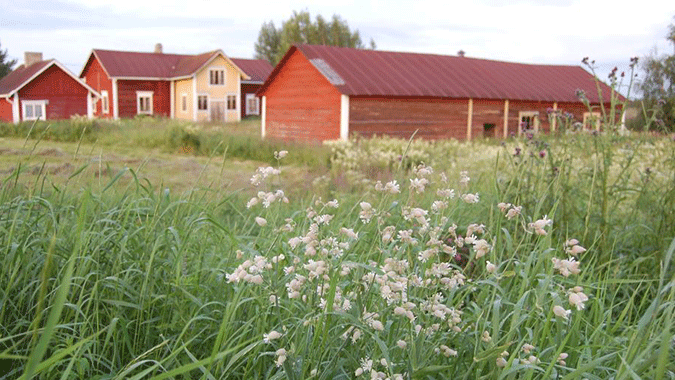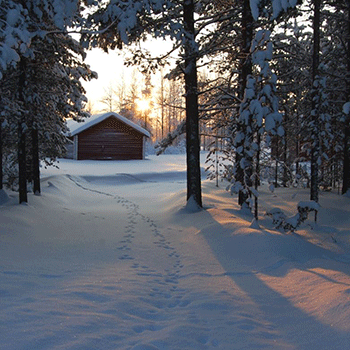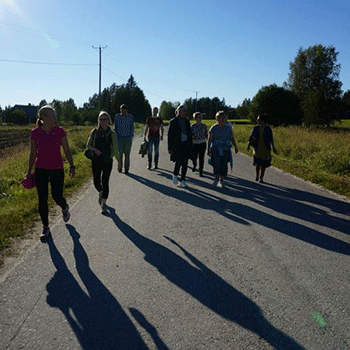Ilona Mettiäinen, researcher and a member of the Northern Political Economy team presents the Suvanto village in Finnish Lapland. This unique place in the Arctic was chosen as venue for the NPE symposium 2015.
Suvanto is a small and remote village in the small municipality of Pelkosenniemi, nearby the Pyhä-Luosto national park in Eastern Finnish Lapland. “Suvanto” means a place in the river where water moves slowly and calmly. Actually, the name describes the village in more senses than just one.
Concretely speaking, the River Kitinen runs slowly by the village – even more slowly now that it was turned into a water reservoir for the Kokkosniva hydroelectric power plant in the early 1990s. Suvanto was saved from drowning due to local activism and attention on the cultural historical value of the village on national level. Nowadays the hydroelectric water reservoir, including the riverbanks in the village, serves as an example of good landscape architecture in hydroelectric power production.

Beyond the factual slowness of the river, sometimes it feels like time was running more calmly in this village. Without the modern-day cars and people dressed in contemporary clothes, for a blink of an eye the spectators of the village milieu and landscape might believe they have travelled in time.
The history of the village dates back to late 1600’s when Finland was still part of Sweden and the national borders in Lapland were still somewhat nonexistent. For strengthening his power there, the King of Sweden gave settlement placations in 1673 and 1695 that allowed families to settle to and start farming on areas North of the old “border” between Lapland (Sámiland) and the agricultural parts of Finland. The border had, until then, reserved also these river banks for the indigenous forest Sámi population. Suvanto was one of the first places to which settlers arrived from more Southern parts of Finland. In addition to good farming land, they were granted exemptions from taxes and military service for some time.
The oldest buildings that you can still see in the village are from the 1700s and several more date back to the 1800s. In Lapland that is certainly exceptional! When you see the thick logs in the walls of these centuries old buildings, still in excellent condition - that’s something I would call sustainable use of natural resources.

The uniqueness of the village results in a way from the aftermath of the 2nd World War, when most of the other villages in Lapland were burnt down by the retreating German troops. The so-called Lapland’s war in 1944-1945 is often forgotten when talking about the WW II, but it had devastating effects for the county. Nearly all villages north from Rovaniemi were burnt down, and only some remote houses, and occasionally churches, survived. The entire Suvanto village, however, was left unharmed. For decades people have been speculating why. I guess we’ll never know for sure, but explanations have varied from a love story between a German soldier and a girl from the village to the undeniably long way to the isolated village and the soldiers’ difficulties to get across the river.

Whereas in the 1930s there were as many as 300 inhabitants in the village, nowadays Suvanto has some 20-30 inhabitants, most of them elderly people, and most of the houses are only used in the summer time. The village is referred to as a “museum village” in some (slightly outdated) maps, but all the houses – except for the old school building – are privately owned and highly appreciated family estates. The value of the Suvanto village has been recognized also nationally and internationally. The whole village was renovated with the expertise and some financial support of the National Board of Antiquities of Finland in late 1980s and early 1990s, and the Europa Nostra prize that the village was awarded in 1991 shows the international appreciation.
The Northern Political Economy team of the Arctic Centre held its annual symposium in Suvanto in late August 2015. In addition to two inspiring keynote lectures by our international guests Mitchell Dean and Frank Sejersen and presentations on the participants’ latest research, the group took a sightseeing tour in the village, guided by the NPE team member Ilona. The symposium participants also got a glimpse of everyday life in a remote village in Lapland, including economical activities: in this case (scientific) tourism hosted by a family-run tourism enterprise. After otherwise a cool and rainy summer, the NPE team could see the village in perfect sunshine and warmth.

Text: Ilona Mettiäinen
Photos: Ilona Mettiäinen & Joonas Vola